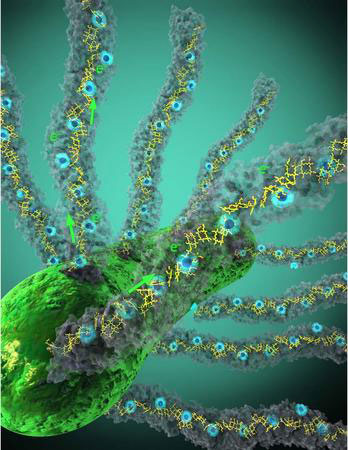Deep in the ocean or underground, where there is no oxygen, Geobacter bacteria “breathe” by projecting tiny protein filaments called “nanowires” into the soil, to dispose of excess electrons resulting from the conversion of nutrients to energy.
These nanowires enable the bacteria to perform environmentally important functions such as cleaning up radioactive sites and generating electricity. Scientists have long known that Geobacter make conductive nanowires – 1/100,000 the width of a human hair – but to date no one had discovered what they are made of and why they are conductive.
A new study by researchers at Yale, University of Virginia and the University of California at Irvine published April 4 in the journal Cell reveals a surprise: the protein nanowires have a core of metal-containing molecules called hemes.
Previously nobody suspected such a structure. Using high-resolution cryo-electron microscopy, the researchers were able to see the nanowire’s atomic structure and discover that hemes line up to create a continuous path along which electrons travel.
“This study solves a longstanding mystery of how nanowires move electrons to minerals in the soil,” said lead author Nikhil Malvankar, assistant professor of molecular biophysics and biochemistry at Yale and a faculty member at the Microbial Sciences Institute.
“It is possible we could use these wires to connect cells to electronics to build new types of materials and sensors.”
Edward Egelman of Virginia and Allon Hochbaum of UC-Irvine are other senior authors. Fengbin Wang of Virginia and Yale’s Yangqi Gu and are co-first authors. Other authors are Yale’s Patrick O’Brien, Sophia Yi, Sibel Ebru Yalcin, Vishok Srikanth, Cong Shen, Dennis Vu and UC Irvine’s Nicole Ing.
Reference: “Structure of Microbial Nanowires Reveals Stacked Hemes that Transport Electrons over Micrometers” by Fengbin Wang, Yangqi Gu, J. Patrick O’Brien, Sophia M. Yi, Sibel Ebru Yalcin, Vishok Srikanth, Cong Shen, Dennis Vu, Nicole L. Ing, Allon I. Hochbaum, Edward H. Egelman and Nikhil S. Malvankar, 4 April 2019, Cell.
DOI:10.1016/j.cell.2019.03.029
1 Comment
Refine, Experiment, ON Nuclear waste 250 tons to Recycle wasted fuel